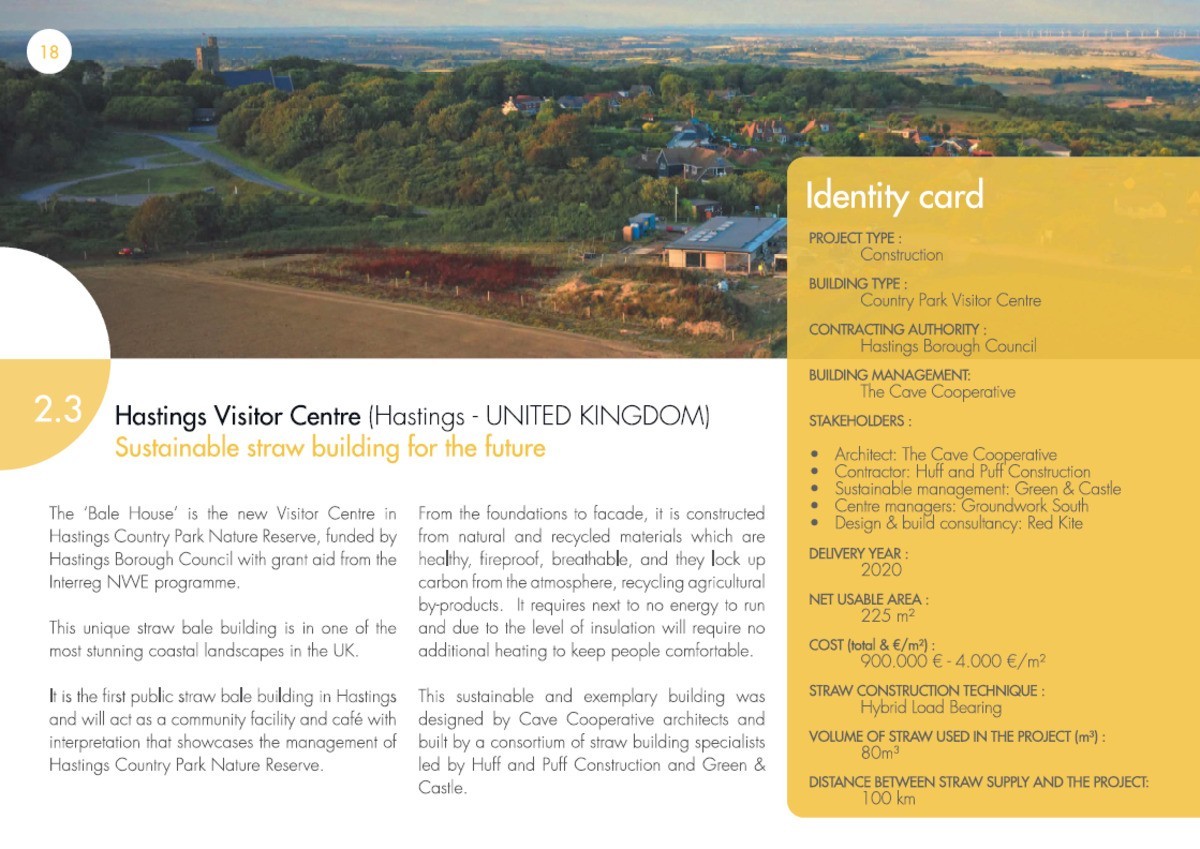Hastings Visitor Centre built with straw

The 'Bale House' is the new Visitor Centre in Hastings Country Park Nature Reserve, funded by Hastings Borough Council with grant aid from the Interreg NWE programme.
From the foundations to facade, it is constructed from natural and recycled materials which are healthy, fireproof, breathable, and they lock up carbon from the atmosphere, recycling agricultural by-products. It requires next to no energy to run and due to the level of insulation will require no additional heating to keep people comfortable.
This unique straw bale building is in one of the most stunning coastal landscapes in the UK.
It is the first public straw bale building in Hastings and will act as a community facility and café with interpretation that showcases the management of Hastings Country Park Nature Reserve.
This sustainable and exemplary building was designed by Cave Cooperative architects and built by a consortium of straw building specialists led by Huff and Puff Construction and Green & Castle.
Background
At the European Straw Bale Gathering in 2015, the School of Natural Building (SNAB) was invited to become a partner in a bid for Interreg funding, which ultimately became UP Straw. Each UP Straw partner searched for an organisation who wanted to build. SNaB had previously had conversations with Cave Cooperative architects who had been asked to design a Visitor Centre for Hastings Borough Council. SNaB introduced Hastings Borough Council to the UP Straw project via Groundwork South. The rest, as they say, is history...
Public procurement and the build process
Work started in 2019 as the first tyres were filled and a frame of heavy Douglas fir beams to hold the bales was put together. The planning process began 5 years earlier. The challenges tackled by the project team have generated valuable lessons for public authorities wanting to build future proofed energy efficient structures.
To make it possible, the tender process was adapted to suit the needs of this ground-breaking project. After two invitations to tender failed, the council reached out to sustainable contractors to form a consortium of straw bale builders. Murray Davidson, Project lead from Hastings Borough Council says, "The council took a risk and spent a lot of time making the project work, but we have shown that straw bale construction can be a normal and central part of local authority procurement."
Councillor Maya Evans Lead Councillor for the Natural Environment and Leisure further comments, "Although constructing a new building from straw bales and sustainable materials present new and difficult challenges for the authority, it is a measure of our commitment to help address the climate crisis the planet faces." The challenges imposed by the global pandemic have delayed the construction. It is expected to be completed by the end of 2020 but not open until 2021 due to Covid restrictions.
Straw Supply and Storage
Following the council decision to build a straw bale centre, 80 cubic metres of straw were procured in 2016. The straw was stored in council-owned farm buildings at Hastings Country Park, where it remained in excellent condition until needed in 2019.
Construction Method
Phil Christopher from Huff and Puff Construction describes the method of construction, "The building was originally envisaged as load bearing straw bale, however we used a method where we erected a lightweight timber frame first and then infilled the straw. Essentially the framing is identical to robust load bearing methods, just with more posts.
It often refer to this method as a hybrid, since the straw is still a structural part of the walls, both for load and racking. This method was a good fit for our teams and for the site - which is incredibly exposed, being over 150m above sea level and on the edge of a cliff. We experienced winds of approximately 70mph about six times over the course of the build and anchoring the building solidly was imperative.”
Fire Regulations
(...) Read the full article on nweurope.eu



